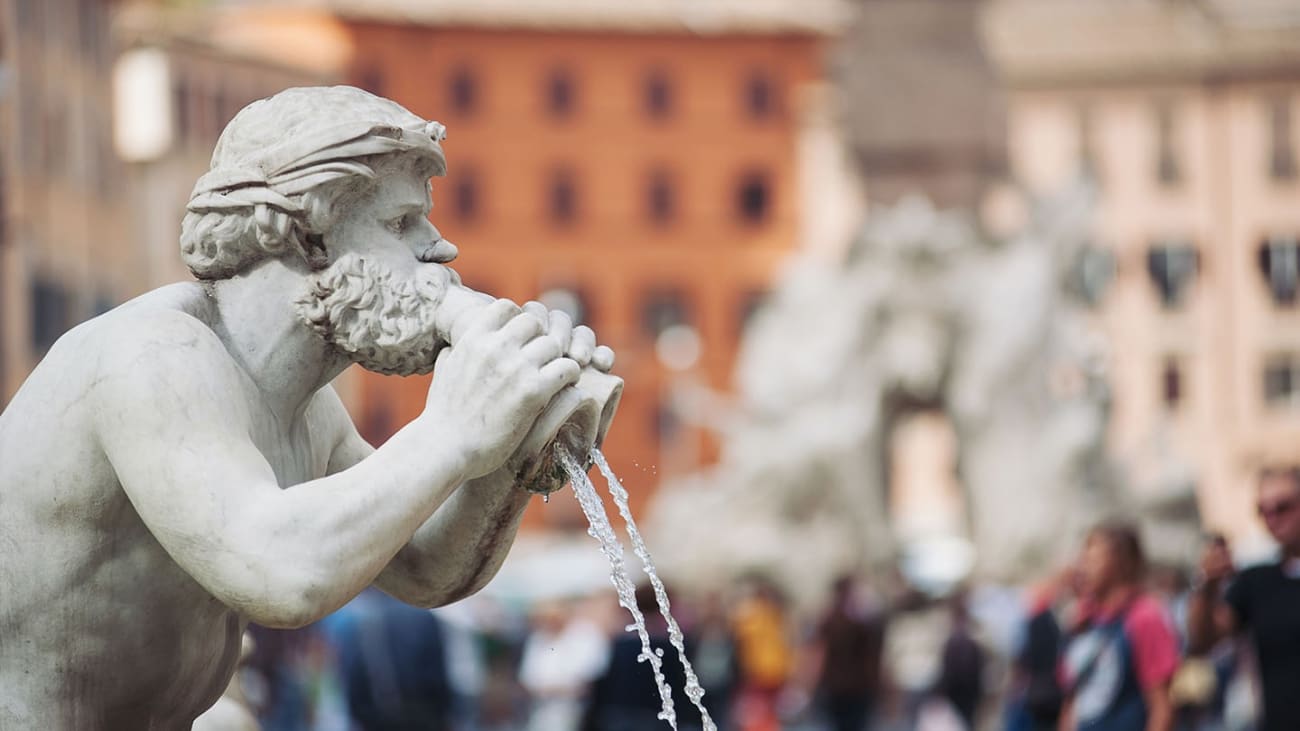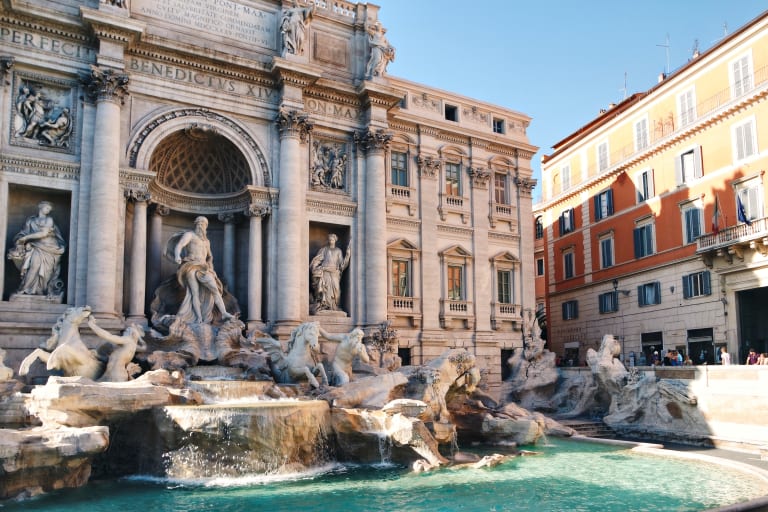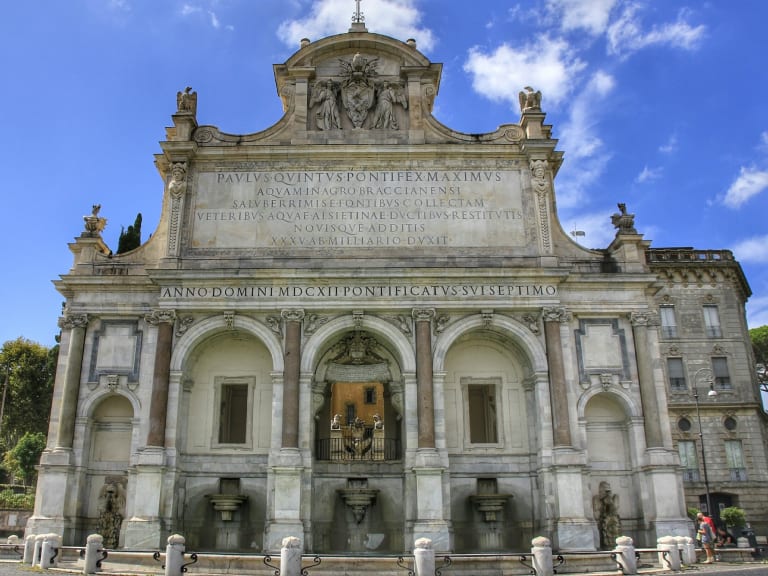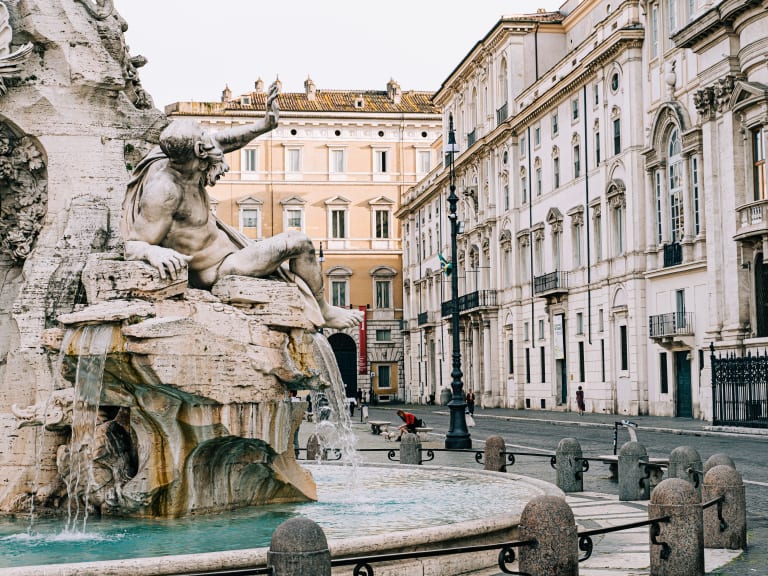Top 5 Fountains in Rome
Throughout the city you will find majestic fountains presiding over Rome's squares. Here's a list of the best so you don't miss any of them.

One of the fountains in Piazza Navona | ©Shutterstock
Water has traditionally been an element of great importance in the architecture of Rome: its aqueducts brought water to every corner of the ancient empire, which was a symbol of greatness.
But water is also considered the element that best represents purity in art, and this explains why the Eternal City has an endless number of fountains, in which such a precious treasure is displayed in thousands of different ways. Of the more than 2,000 fountains in the city, here is a list of my favourites and the ones I think you can't miss. Here are the 5 most beautiful fountains in Rome.
1. Trevi Fountain

The Trevi Fountain is the most famous fountain in Rome and probably in the whole world. It is an imposing set of sculptures in baroque style that rises above a pool of clear water in a spectacle for the eyes.
After Anita Ekberg bathed in the Trevi Fountain in Fellini's film 'La Dolce Vita', the fountain became a place of pilgrimage and a whole series of traditions survive around it, such as throwing coins into the fountain to bring good luck, to make sure you will return to Rome, or to find love.
The fountain is an allegory of the taming of the sea, with the central statue of Oceanus (the god Neptune) in the main niche mounted on a shell chariot, pulled by sea horses and tritons, between two statues representing health and abundance. The two horses, one tame and the other wild, represent the two states of the sea.
Bernini was the originator of the original idea for the Trevi Fountain, but on the death of Pope Urban VIII the sculptor and architect fell into disgrace without his patron. Using his original plans, Nicola Salvi continued the project under the papacy of Clement XII and completed it almost a century after Bernini's first vision of this iconic fountain.
Where it is and how to get there
It is located on Via delle Muratte in the Trevi district. To get there directly, the nearest metro stop is Barberini, but most people walk from the Spanish Steps in a single journey.
2. Acqua Paola Fountain

This fountain can be considered the sister of the Trevi Fountain: designed by Giovanni Fontana, it was originally intended as a set of five small pools, but at the time of its construction the architect decided to unify them into a single pool, based on a design by Bernini for the Trevi Fountain that was never realized.
The Fontana dell'Acqua Paola, also known as Il Fontanone, is a monumental fountain located on the Gianicolo hill. It was built in 1612 at the end of the Acqua Paola aqueduct, named after Pope Paul V who ordered its restoration.
Being at the top of the hill, the site of the fountain has a certain aura, especially at sunset when you can enjoy a beautiful view of Rome while listening to the water of the fountain flowing. The simplicity and elegance of the fountain convey a lot of peace, and one detail I couldn't help but notice was the small inner courtyard behind the façade illuminated by the last rays of the sun.
Where it is and how to get there
To get to the Fontana dell'Acqua Paola (located on Via Garibaldi) from the centre, the best way is to take bus 115 and get off at the Garibaldi/Iacobucci stop. You can also easily walk there from Trastevere, so visiting this majestic fountain is an ideal way to continue your day after a guided tour of the Trastevere neighbourhood.
3. Fountain of the Rane

The Fontana delle Rane, or Fountain of the Frogs, is in the centre of the beautiful Coppedè neighbourhood, one of the secret corners of the Eternal City that most tourists don't know about. If I've just made you curious, you can read more about this neighbourhood and other unknown places in Rome.
Personally, I find this fountain one of the most beautiful in Rome: the grass grows between the small sculptures of frogs and this gives it the appearance of a ruin forgotten by time in a fairy tale, a sensation that is intensified when you look up and see the magical buildings of Coppedè.
According to the story, on a night in 1965 this fountain served the Beatles as a pool in which to take a dip, after a drink at a famous nearby bar, the Piper, which was also frequented by other legendary bands such as the Rolling Stones and Pink Floyd.
Where it is and how to get there
There are no metro stations near Coppedè, so the easiest way to get there by public transport is to take tram 3 or 19 or bus 60, 66 or 69 to the Buenos Aires stop and walk to the corner of Via Dora and Via Tagliamento.
4. The Quattro Fiumi Fountain

This fountain occupies the central place in the famous Piazza Navona, so whatever you do in Rome I'm sure it's impossible to miss it. The translation of its name would be the Fountain of the Four Rivers, and the fountain's four sculptures represent the river gods of the four continents: the Danube (Europe), the Rio de la Plata (America), the Nile (Africa) and the Ganges (Asia).
Designed by Bernini, the great architect of Baroque Rome, the fountain is like a compass rose marking north, south, east and west, with Rome as the centre of the world. The obelisk rising above the sculptures, from the Circus of Maxentius, adds an imposing majesty to the whole.
Something that I found very beautiful when I saw the fountain in detail is that each river is represented by an animal symbolic of each continent. Thus, the Nile becomes a lion under a palm tree, the Rio de la Plata is a crocodile and a cactus, the Danube a galloping horse over a field of flowers and the Ganges is represented by a dragon and an oar.
Where it is and how to get there
Somehow or other you will pass through Rome's Piazza Navona, as all guided city tours of Rome make a stop here. The square does not have a metro station per se, but you can get there by buses 40, 60 and 64 from various parts of the city.
5. Tritone Fountain

The Triton Fountain is in Piazza Barberini, and at this point I'm sure you can guess who its creator was. Again, Bernini, but this time there is a detail that makes this fountain unique: it was entirely designed and sculpted by the artist.
It was the first commission for a public fountain that the artist received, in 1643, and he managed to create such a masterpiece that his reputation as Rome's sculptor was established for many more works, as you have read, and as you can see on your trip.
The fountain is a symbolic celebration of the papacy of Urban VIII, who was to become Bernini's patron. Therefore, the central theme of the work shows the god Triton projecting a jet of water through a conch shell, on top of a huge seashell supported by dolphins, a symbol of the goodness of the papacy. But you can also see some elements such as the engravings of the bees, a symbol that appears on the coat of arms of Barberini, the Pope's house.
Where it is and how to get there
To get to Piazza Barberini, the most direct way is to take the metro to the stop of the same name, on line A. There are also plenty of buses. There are also plenty of buses to take you there: 52, 53, 56, 58, 58, 58, 60, 61, 95, 116, 175, 492 and 590.
